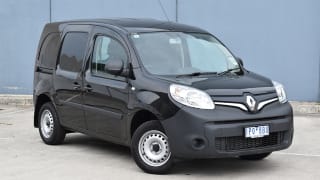Fun fact: along with the Berlingo, the French-built Partner is also sold in Europe as an Opel/Vauxhall Combo (descendent of the SB and XB Barina Combo, Holden fans) as well as the Toyota ProAce City. There’s another Toyota connection too, which we’ll get to in a moment.
Priced from $31,490 before on-road costs (ORC), the Partner L1 130 THP is the only automatic version available, as well as the best equipped of the range.
‘L1’ refers to the shorter of the two body and wheelbase lengths on offer and ‘130 THP’ is the 1.2-litre three-cylinder turbo petrol engine’s metric horsepower rating (translating to 96kW), driving the front wheels via a Toyota-built eight-speed torque-converter automatic transmission.

Buyers can save money with the $25,990 L1 110 THP (82kW) version or $30,490 L2 92 HDI; in Peugeot-speak L2 means 'longer', adding a 350mm and 190mm body and wheelbase stretch respectively, while 92 HDI refers to a 68kW 1.6-litre four-cylinder turbo-diesel. Both cheaper grades come only as a manual.
Safety features include autonomous emergency braking (AEB), lane departure warning (LDW), anti-lock brakes (ABS) with Electronic Brake-force Distribution (EBD) and Emergency Braking Assist, electronic stability control (ESC), four-wheel disc brakes, six airbags (for driver, passenger and front side curtain), front and rear parking sensors, speed-sign recognition, cruise control with an electronic speed limiter, electric parking brake, a surround-view camera system that provides both parking and a rear-vision-mirror-style projection and an internal central locking system. Not bad for a van.
On the comfort and convenience side there’s ‘2+1’ three-seater bench, a driver’s seat height adjuster, climate control air-conditioning with pollen filter, auto on/off headlights with a timing function, static cornering lights, front fog lights, an electronic instrumentation layout, Apple CarPlay/Android Auto connectivity, Bluetooth phone and audio streaming, a tilt/telescopic multi-function steering wheel with remote controls, paddle shifters, central locking, power windows, dual sliding side doors, a glazed bulkhead separating passenger and cargo areas, rear barn doors and a full-sized spare wheel.

Too bad adaptive cruise control isn't offered on Aussie-bound Partners, though.
That three-seater bench arrangement includes Peugeot’s Multi-Flex modular folding passenger seat, which can provide 1273mm of additional load length or 0.6 cubic metres of volume, accessible via a hatch in the bulkhead. The centre backrest folds to reveal extra storage or a sliding bench top table.
You get the jam as well as the butter in this glorified bread van.
As far as rivals are concerned, the Partner makes a compelling case for itself, especially as it is by far the youngest in a class featuring decade-plus old small vans at the time of writing.
Now in runout, the cheapest old-shape Caddy auto is the TSI 220 petrol Crewvan (with two rows of seats) from $35,040 before ORC with a dual-clutch auto (DCT), while the in-coming (from July) all-new Caddy 5 Cargo TDI 320 diesel auto starts from a hefty $38K, and with no petrol equivalent slated for Oz for now.
Meanwhile, the Kangoo Compact 1.2-litre turbo DCT auto petrol is just $28,490 but it lacks driver-assist safety tech like AEB and LDW, curtain airbags, as well as a third seat, climate control, Apple CarPlay/Android Auto, glazed bulkhead and other goodies at that price point. An all-new version was recently rolled out in Europe, but that may years away from Australia. Nobody knows exactly.
As it stands, advantage Partner.
Options include windows for the side and rear doors, roof racks, tow bar, and extra cargo area accessories like wooden side and floor panels for body protection and insulation, rubber floor coverings, carpets and additional rear interior lighting.





















